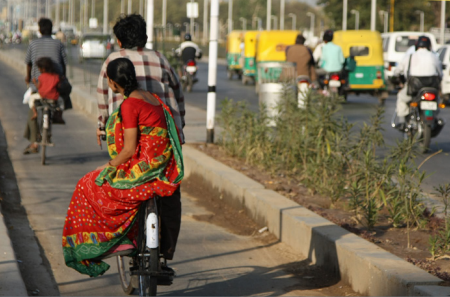LEDS in Practice: Make roads safe by reducing greenhouse gas emissions from urban transport

Introduction
Low Emissions Development Strategies (LEDS) are central to the efforts of developed and developing countries to mitigate current and future greenhouse gas emissions, which if unchecked will accelerate climatic change and further exacerbate existing vulnerabilities, and thereby undermine efforts to adapt to climate change.
As a result of various push-pull factors, including impacts relating to climate change, migration from rural to urban settings (urbanisation) is increasing. This is increasingly exerting pressure on the capacity of cities, requiring interventions in order to maintain the health and security of their growing populations. In parallel to this, economic growth in developing and developed countries alike is resulting in an increased need for, and dependence on, public and private transport. This presents both a challenge and opportunity for cities to mitigate increasing air pollution and carbon emissions. In response to this the Transport Working Group at Low Emission Development Strategies Global Partnership (LEDS GP) has released a series of papers exploring the many benefits of low carbon urban transport (see links under further resources), of which this is one.
Make roads safe
As the demand for motorized commuting increases in low and middle income countries, nonmotorized transport road users become especially vulnerable to road traffic accidents and require better policymaking in this sector.
Developing countries have a relatively high share of pedestrians and cyclists. It is clear that increasing low carbon modes of transport and converting these modes into mainstream transport would not only save carbon emissions but also safeguard citizens’ health and wellbeing. Traffic related crashes and accidents cause heavy losses to life and property, in turn creating costs to the economy. Such losses of life can also exacerbate existing vulnerabilities in poorer communities through the loss of key family and community members.
In India in 2010, for example, nearly 134,000 people were killed in traffic accidents. This translates into annual economic losses from road accidents of 3% of India’s gross domestic product. Motorized two and three wheelers, often used as an alternative to poor public transport services in low and middle income countries, had the greatest share of casualties, with almost a third of the total number. With the continued trend towards private motorization, it is estimated that by 2020 road traffic injuries will be the third largest cause of premature deaths worldwide—more than malaria, HIV, or tuberculosis.
City investments in low carbon transport structures such as bicycle lanes and pedestrian pathways would promote commuter safety on the roads. Increased safety due to low carbon transport would save lives, property, and money, all of which are impacted by road collisions, reducing gross national product by about 4% worldwide.
This paper* shares two case studies from cities that have taken action in the transport sector to make their roads safer and have seen the benefits in reduced road fatalities and emissions. It describes the Congestion Charge in London, UK and Janmarg bus rapid transit system in Ahmedabad, India, and provides details of the design, implementation and the results of these projects to date.
*download from the right-hand column or via the link under further resources.
Key Messages
- The UN Decade of Action for Road Safety (2011–20) is aiming to reduce road traffic fatalities by 50% by 2020 compared with the 2010 baseline.
- Low carbon transport offers a practical opportunity to safeguard citizens as they go about their daily lives, at the same time as reducing greenhouse gas emissions from urban transport systems.
- Cities can prevent death and injury on their roads as the reduction of greenhouse gas emissions in the urban transport sector is accompanied by a significant reduction in private vehicles and improvement in infrastructure for pedestrians and cyclists.
LEDS in Practice
This paper is one of a series on the co-benefits of low emission development strategies in the transport sector, from the LEDS GP Transport Working Group, World Resources Institute’s Ross Center for Sustainable Cities (EMBARQ) and GIZ. View the others here:
- LEDS in Practice: Breathe clean
- LEDS in Practice: Fight poverty
- LEDS in Practice: Save money and time
- LEDS in Practice: Create jobs
The LEDS GP Transport Working Group provides technical assistance, tools, and training for LEDS in transport systems. The group works to:
- share approaches and practices for transport and land use planning n provide transport analysis methods and tools
- offer peer to peer, transport-specific financial training and expert assistance.
Contact: [email protected]
Suggested Citation
Lefevre, B., Eisenbeiß, K., Yadav, N. and Enriquez, A. (2016) Make roads safe by reducing greenhouse gas emissions from urban transport. LEDS in Practice. Low Emission Development Strategies Global Partnership.
(0) Comments
There is no content